An illustrated glossary
Battle of the Châteauguay National Historic Site
The following illustrated glossary provides a series of definitions and pictures that will be of help in grasping the context of the War of 1812.
- Abattis
- Canadian Fencibles
- Canadian Voltigeurs
- Ford
- Hampton, Wade
- Haversack
- Indigenous
- Madison, James
- Militia
- Prevost, George
- Salaberry, Charles-Michel d'Irumberry de
- Sedentary Militia
- Selected Embodied Militia
- Wilkinson, James
Abattis
An obstacle created by felling trees across a route so as to interlace with other trees. (Term and definition officialized by the Engineers Terminology Working Group)
Indigenous
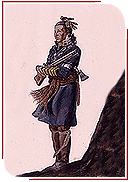 Indigenous scout
Indigenous scout© Parks Canada / G.A. Embleton / X.78.138.2
Indigenous military corps were levied during the War of 1812. About 250 to 300
Indigenous took part in military action in the course of this war. Among other
things, the military authorities relied on the Amerindians' knowledge of the
territory and their skill at laying ambushes.
Canadian Fencibles
 Illustration of a Canadian Fencibles soldier
Illustration of a Canadian Fencibles soldier© Parks Canada / Victor J. H. Suthren
The Canadian Fencibles is a provincial regiment of light infantry composed of regular soldiers (as opposed to militiamen), recruited in British North America. Under the orders of Captain Ferguson, a Canadian Fencibles company took part in the Battle of the Châteauguay. Before the war began, other Fencibles regiments were recruited in three maritime provinces (Newfoundland, Nova Scotia and New Brunswick) to serve in North America.
Canadian Voltigeurs
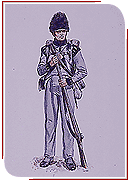 Soldier in the Canadian Voltigeurs wearing the grey and black uniform with a bearskin cap
Soldier in the Canadian Voltigeurs wearing the grey and black uniform with a bearskin cap© Parks Canada / G. A. Embleton
The Canadian Voltigeurs were a corps of light infantry formed by a group of volunteer soldiers. Raised by Charles-Michel de Salaberry during the War of 1812, this corps of militiamen enlisted recruits for the duration of the war.
Ford
Shallow part of a watercourse that may be crossed on foot, on horseback, or by land vehicle. (Terminology validated by the Canadian Permanent Committee on Geographical Names ( CPCGN )
Hampton, Wade
Major General Wade Hampton commanded an American army that attempted to reach Montréal via the Châteauguay River valley. Hampton headed the American troops during the battle of the Châteauguay.
Haversack
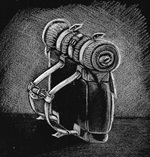 Drawing
of a haversack, soldier's canvas knapsack with leather straps, used to carry
personnal belongings.
Drawing
of a haversack, soldier's canvas knapsack with leather straps, used to carry
personnal belongings.© Parks Canada / Andrélise
This soldier's knapsack was made of a wood frame covered with heavy canvas. It
was used by soldiers to carry personal belongings such as a change of clothing,
a repair kit for their uniform, mess tin and utensils, etc. A blanket or coat
was generally placed in a roll on top of the haversack.
Madison, James
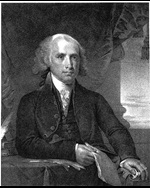 James Madison, 4th president of the United States (1809-1817)
James Madison, 4th president of the United States (1809-1817)© Library of Congress / Pendleton / LC-USZ62-3462DLC
James Madison, President of the United States from 1809 to 1817, obtained adoption of a declaration of war against England by Congress on June 18, 1812.
Militia
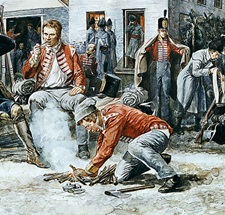 Group of militiamen
Group of militiamen© Parks Canada / G. A. Embleton
Under the British colonial administration, all men from 16 to 60 years of age were compelled to perform military service in the militia. Militia officers were responsible for training militiamen several days every year. Whenever war broke out, militias were called up to aid the regular army in repelling enemy attacks. During the War of 1812, Lower Canada numbered three types of militia: Sedentary Militia corps, Volunteer corps, and Select Embodied Corps.
Prevost, George
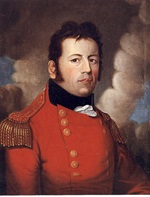 Lieutenant General Sir George Prevost
Lieutenant General Sir George Prevost© Museum of Château Ramezay, Montréal / Jean-Baptiste Roy-Audy / 1998-573, 1824
Sir George Prevost was Governor General and Commander in Chief of British and Canadian troops in Upper and Lower Canada during the War of 1812.
Salaberry, Charles-Michel d'Irumberry de
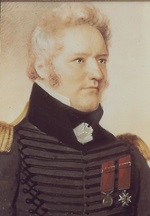 Charles-Michel
d'Irumberry de Salaberry
Charles-Michel
d'Irumberry de Salaberry© Museum of Château Ramezay, Montréal / Anson Dickinson / 1998-1151, 1825
Lieutenant Colonel Charles-Michel d'Irumberry de Salaberry commanded the victorious
Canadian troops during the battle of the Châteauguay. De Salaberry was
also the man entrusted with levying the Canadian Voltigeurs on April 15, 1812.
Sedentary Militia
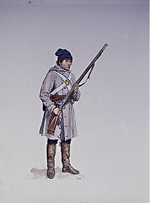 Member of the Sedentary Militia
Member of the Sedentary Militia© Parks Canada / G. A. Embleton
The Sedentary Militia included men who had to enrol each year in the local militia for military drills and training. In time of war, Sedentary Militiamen were called on to aid the mobilized regulars.
Selected Embodied Militia
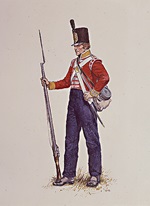 Soldier in the Selected Embodied Militia
Soldier in the Selected Embodied Militia© Parks Canada / G. A. Embleton
The Selected Embodied Militia was created on May 28, when Governor George Prevost
ordered the enrolment (drafting) of 2 000 militiamen, who were chosen by
the drawing of lots. Four battalions were formed up at once to aid the regular
army. Additional major enrolments were carried out until the end of the war.
Wilkinson, James
Major General James Wilkinson commanded a second American army, which aimed at reaching Montréal via the upper St. Lawrence Valley.
Related links
- Date modified :